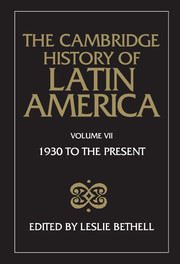15 - The Panama Canal Zone, 1904–79
from PART FOUR - Panama
Published online by Cambridge University Press: 28 March 2008
Summary
In the history of twentieth-century Latin America, the Panama Canal – and the Canal Zone – have always possessed a great emblematic significance. The canal runs through the territory of a tiny Hispanic republic dependent from birth on the patronage of the United States, and for seventy-five years its operation was under exclusive U.S. control. Throughout the century the canal has been an outstanding symbol of Washington's power to dominate the weaker states of the hemisphere.
U.S. determination to control the transit across the isthmus of Central America dates from the 1840s, when the Union reached the North American Pacific seaboard. In 1846 a treaty with New Granada (Colombia) gave Washington a right of way across Panama, then a province of Colombia, in exchange for a U.S. guarantee of Colombian sovereignty over the province, and by 1855 the American-owned Panama Railroad was in business. The railway was seen by some as the forerunner of a U.S.-controlled canal, but by the Clayton–Bulwer Treaty of 1850 Britain had insisted on an equal share in any future canal project, and the attractiveness of trans-continental railroads further reduced North American canal promotion. In the event, it was the French who began work on a Panama seaway in the 1880s under de Lesseps, architect of the Suez Canal, although the venture collapsed well short of completion.
In spite of the French débâcle, U.S. pressure for a canal was sustained, most notably by advocates of naval power such as Captain Alfred Mahan and his admirer Theodore Roosevelt, and it was given a huge stimulus by the war with Spain in 1898, when the battleship Oregon had to steam from Seattle to Cuba via Cape Horn.
- Type
- Chapter
- Information
- The Cambridge History of Latin America , pp. 643 - 670Publisher: Cambridge University PressPrint publication year: 1990

